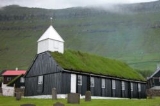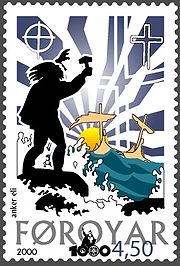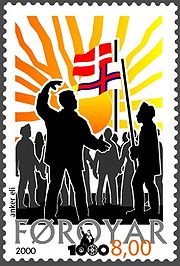
Church of the Faroe Islands
Encyclopedia
The Church of the Faroe Islands
(Faroese
Fólkakirkjan) was a diocese of the Lutheran Church of Denmark
until it became independent on 29 July 2007, as the smallest of the world's few remaining state church
es.
About 85% of the Faroese people
belong to the state church. Other churches include the Plymouth Brethren
and Roman Catholics
.
 According to the Færeyinga Saga
According to the Færeyinga Saga
, it was the Viking chief Sigmundur Brestisson
, who brought Christianity to the Faroe Islands. On the orders of the Norwegian King Olav Trygvason, Sigmundur forced the island people to convert to Christianity in 999 AD. Resistance to the new religion, led by the notorious Tróndur í Gøtu
, was quickly suppressed; and even though Sigmundur himself lost his life, Christianity gained a foothold.
and subject to the archbishop of Nidaros (Tróndheim) for most of the time. From the time Christianity was introduced until the Reformation there were probably 33 bishops in the Faroe Islands.
This period was not always peaceful. The sagas of the Faroe Islands contain two accounts of the way the church took possession of a large proportion of the land, overtaxing the people so harshly that it led to open rebellion. The saga of the battle of Mannafallsdal relates that the bishop (probably Bishop Erlend, appointed in 1269) was killed outside his church by the rebels. The historical value of this saga is highly debatable - but it does serve to illustrate the conflict between the theocratic church and an impoverished population. However, there is reasonable documentation of the fact that the bishop's residence in Kirkjubø was burnt to the ground by the rebels, and that Erlend was removed from the islands by order of the King. Bishop Erlend died in Bergen in 1308.
 See main articles: Faroese language conflict
See main articles: Faroese language conflict
, The Christmas Meeting 1888
When the Danish trade monopoly was lifted in 1856, Faroese society started to boom both economically and culturally. The restoration of long-suppressed Faroese culture also led to changes in Christianity on the islands. After great contention, Faroese was given the same status as Danish as the language used in hymns and preaching in 1924-25. The ecclesiastical rituals (christening, burial, marriage etc.) were introduced in Faroese in 1930, and in 1961 the authorised Faroese edition of the Bible was published. During the first half of the 20th century, Dean Jákup Dahl
had translated the New Testament from Greek - this was published in 1937. Dahl also translated the psalms from the Old Testament, and after his death in 1944 a vicar named Kristian Osvald Viderø
continued to translate the rest of the Bible from Hebrew. In 1963 the first Faroese hymn book was published, and in the same year the old title of Dean on the islands was upgraded to Deputy Bishop. In 1977 the first female vicar was ordained, and in 1990 the Faroe Islands became an independent diocese with its own bishop within the Church of Denmark.
In 2005 the Faroes signed a treaty with Denmark that allows for the taking over of most public institutions, including the Vágar Airport
and the People's Church. On the National Holiday Ólavsøka
29 July 2007, the Faroese Church became totally independent of the Church of Denmark.
Faroe Islands
The Faroe Islands are an island group situated between the Norwegian Sea and the North Atlantic Ocean, approximately halfway between Scotland and Iceland. The Faroe Islands are a self-governing territory within the Kingdom of Denmark, along with Denmark proper and Greenland...
(Faroese
Faroese language
Faroese , is an Insular Nordic language spoken by 48,000 people in the Faroe Islands and about 25,000 Faroese people in Denmark and elsewhere...
Fólkakirkjan) was a diocese of the Lutheran Church of Denmark
Church of Denmark
The Evangelical Lutheran Church in Denmark, Church of Denmark or Danish National Church, is the state church and largest denomination in Denmark and Greenland...
until it became independent on 29 July 2007, as the smallest of the world's few remaining state church
State church
State churches are organizational bodies within a Christian denomination which are given official status or operated by a state.State churches are not necessarily national churches in the ethnic sense of the term, but the two concepts may overlap in the case of a nation state where the state...
es.
About 85% of the Faroese people
Faroese people
The Faroese or Faroe Islanders are a Germanic ethnic group native to the Faeroe Islands. The Faroese are of mixed Norse and Gaelic origins.About 21,000 Faroese live in neighbouring countries, particularly in Denmark, Iceland and Norway....
belong to the state church. Other churches include the Plymouth Brethren
Plymouth Brethren
The Plymouth Brethren is a conservative, Evangelical Christian movement, whose history can be traced to Dublin, Ireland, in the late 1820s. Although the group is notable for not taking any official "church name" to itself, and not having an official clergy or liturgy, the title "The Brethren," is...
and Roman Catholics
Roman Catholicism in the Faroe Islands
The history of Roman Catholic Church in the Faroe Islands goes back to the year 999, when king Olav Tryggvason of Norway sent Sigmundur Brestisson on a mission to the islands with several priests. The islands became an independent diocese in 1111, but were officially reformed in 1537 and the last...
.
Christianisation

Færeyinga Saga
The Færeyinga Saga , the Norse saga of Faroemen, is the story of how the Faroes were converted to Christianity and became a part of the Kingdom of Norway.-Summary:It was written in Iceland shortly after 1200...
, it was the Viking chief Sigmundur Brestisson
Sigmundur Brestisson
Sigmundur Brestisson introduced Christianity to the Faroe Islands in 999. He is one of the main characters of the Færeyinga saga.According to the Færeyinga Saga, emigrants who left Norway to escape the tyranny of Harald I of Norway, settled in the islands about the beginning of the 9th century...
, who brought Christianity to the Faroe Islands. On the orders of the Norwegian King Olav Trygvason, Sigmundur forced the island people to convert to Christianity in 999 AD. Resistance to the new religion, led by the notorious Tróndur í Gøtu
Tróndur í Gøtu
Tróndur í Gøtu was a viking from the Faroe Islands . He and Sigmundur Brestisson are the central figures in the Færeyinga Saga, which tells the early history of the Faroe Islands and the coming of Christianity to the islands, which Tróndur opposed.Chapter 3 of the Saga describes Tróndur as...
, was quickly suppressed; and even though Sigmundur himself lost his life, Christianity gained a foothold.
The Catholic era
About one hundred years after the introduction of Christianity, the Faroese church joined the Catholic mother church, with an episcopal residence in KirkjubøurKirkjubøur
Kirkjubøur is the southernmost village on Streymoy, Faroe Islands and the country's most important historical site.It is located on the west coast and has a view towards the islands Hestur and Koltur.-History:...
and subject to the archbishop of Nidaros (Tróndheim) for most of the time. From the time Christianity was introduced until the Reformation there were probably 33 bishops in the Faroe Islands.
This period was not always peaceful. The sagas of the Faroe Islands contain two accounts of the way the church took possession of a large proportion of the land, overtaxing the people so harshly that it led to open rebellion. The saga of the battle of Mannafallsdal relates that the bishop (probably Bishop Erlend, appointed in 1269) was killed outside his church by the rebels. The historical value of this saga is highly debatable - but it does serve to illustrate the conflict between the theocratic church and an impoverished population. However, there is reasonable documentation of the fact that the bishop's residence in Kirkjubø was burnt to the ground by the rebels, and that Erlend was removed from the islands by order of the King. Bishop Erlend died in Bergen in 1308.
The Reformation
In 1540 the last Catholic bishop in the Faroe Islands was removed from his position. His Protestant replacement only lasted a few years - then he too left the islands and a dean took over as the representative of the church under the Bishop of Zealand in Denmark.The Lutheran Church
The orthodox Lutheran form of Christianity propounded by the Zealand bishop Jesper Brochmand in particular gained a strong foothold in the Faroe Islands, and lasted longer here than in the rest of the Kingdom of Denmark. Brochmand's devotional book dating back to about 1650 and Thomas Kingo's hymns from 1699 constituted a significant proportion of the spiritual life of the islands right up until the twentieth century. Indeed, the expression Brochmandslestur is still used to describe long and, as some might perceive them, boring texts and speeches.The nationalist revival

Faroese language conflict
The Faroese language conflict is a phase in the history of the Faroe Islands in the first half of the 20th century . It was the political and cultural argument between the requirements of the Faroese language in general use, and the Danish language as the official language of the Faroe Islands.At...
, The Christmas Meeting 1888
The Christmas Meeting 1888
The Christmas Meeting 1888 is considered as the official start of the Faroese National Movement.On December 22, 1888 the only newspaper at that time in the Faroe Islands, Dimmalætting, carried the following notice:...
When the Danish trade monopoly was lifted in 1856, Faroese society started to boom both economically and culturally. The restoration of long-suppressed Faroese culture also led to changes in Christianity on the islands. After great contention, Faroese was given the same status as Danish as the language used in hymns and preaching in 1924-25. The ecclesiastical rituals (christening, burial, marriage etc.) were introduced in Faroese in 1930, and in 1961 the authorised Faroese edition of the Bible was published. During the first half of the 20th century, Dean Jákup Dahl
Jákup Dahl
Jákup Dahl was a Faroese Provost and Bible translator. In 1908 he became known as a linguist with the first Faroese grammar lessons for school students.- Life and work :...
had translated the New Testament from Greek - this was published in 1937. Dahl also translated the psalms from the Old Testament, and after his death in 1944 a vicar named Kristian Osvald Viderø
Kristian Osvald Viderø
Kristian Osvald Viderø was a Faroese clergyman, poet and Bible translator. After theological studies in Denmark, he oversaw the completion of a translation of the Old Testament into the Faroese language, which Jákup Dahl had worked on until his death in 1944. He was the parish priest of Hattarvík...
continued to translate the rest of the Bible from Hebrew. In 1963 the first Faroese hymn book was published, and in the same year the old title of Dean on the islands was upgraded to Deputy Bishop. In 1977 the first female vicar was ordained, and in 1990 the Faroe Islands became an independent diocese with its own bishop within the Church of Denmark.
In 2005 the Faroes signed a treaty with Denmark that allows for the taking over of most public institutions, including the Vágar Airport
Vágar Airport
Vágar Airport is the only airport in the Faroe Islands, a self-governing territory of the Kingdom of Denmark, and is located east of Sørvágur. Due to the Faroe Islands' rather anomalous status, the airport is not fully subject to the rules of the European Union...
and the People's Church. On the National Holiday Ólavsøka
Ólavsøka
Ólavsøka is a national holiday of the Faroe Islands, celebrated on July 29. It is the day when Løgting, the Faroese Parliament, opens its session....
29 July 2007, the Faroese Church became totally independent of the Church of Denmark.
Renowned clergymen
- Lucas DebesLucas DebesLucas Jacobsøn Debes was a Danish priest, topographer and celebrated writer about the Faroe Islands. He wrote the first book about the Faroes, which was printed and draw the first detailed map of the islands.-His Arrival to Tórshavn:Debes came to the Faroe Islands in 1652 as a curate...
(1623–1675), Provost of the Faroes, issued the first book about the archipelago. - V. U. Hammershaimb (1819–1909), Provost of the Faroes, invented the Modern Faroese grammar.
- Fríðrikur PetersenFríðrikur PetersenFríðrikur Petersen was a noted Faroese politician and clergyman of the Faroese People's Church , a form of Lutheranism.-See also:*Faroese People's Church...
(1858–1917), Provost of the Faroes, poet and politician. - Jacob Dahl (1878–1944), Provost of the Faroes, bible translator.
- Kristian Osvald ViderøKristian Osvald ViderøKristian Osvald Viderø was a Faroese clergyman, poet and Bible translator. After theological studies in Denmark, he oversaw the completion of a translation of the Old Testament into the Faroese language, which Jákup Dahl had worked on until his death in 1944. He was the parish priest of Hattarvík...
(1906–1991), theologian, finished Dahl's translation.
Other Nordic Evangelical Lutheran churches
- Church of SwedenChurch of SwedenThe Church of Sweden is the largest Christian church in Sweden. The church professes the Lutheran faith and is a member of the Porvoo Communion. With 6,589,769 baptized members, it is the largest Lutheran church in the world, although combined, there are more Lutherans in the member churches of...
- Svenska kyrkan - Church of NorwayChurch of NorwayThe Church of Norway is the state church of Norway, established after the Lutheran reformation in Denmark-Norway in 1536-1537 broke the ties to the Holy See. The church confesses the Lutheran Christian faith...
- Den norske kirke - National Church of Iceland - Þjóðkirkjan
- Evangelical Lutheran Church of FinlandEvangelical Lutheran Church of FinlandThe Evangelical Lutheran Church of Finland is the national church of Finland. The church professes the Lutheran branch of Christianity, and is a member of the Porvoo Communion....
- Suomen evankelis-luterilainen kirkko (Swedish: Evangelisk-lutherska kyrkan i Finland) - Church of the Faroe Islands - Hin føroyska fólkakirkjan
External links
- Folkakirkjan.fo - Homepage (in Faroese)
- Tjatsi.fo - Thousand Years of Christianity (by Anker Eli PetersenAnker Eli PetersenAnker Eli Petersen is a Faroese writer and artist.He is most known for his many Faroe Islands postage stamp designs under the name Anker Eli. Many of his stamps depict scenes from Norse mythology, Christianity, or interpretations of other Faroese authors or poets...
) - Photo-site Faroese Churches

